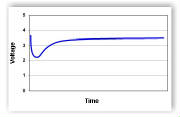Passivation
Lithium batteries are affected by a phenomenon known as passivation.
Passivation is a film of lithium chloride (LiCl) that forms on the surface of the lithium anode, and it serves to protect
the lithium from discharging on its own when the load is removed from the cell. The film of LiCl, which is essentially
a high resistance layer between the electrodes, is primarily responsible for the long shelf life (>10 years) of lithium
cells.
Passivation may cause voltage delay
after a load is placed on the cell as illustrated in the following drawing:

After a load is placed on a cell, the high resistance
of the passivation layer causes the cell's voltage to dip. The discharge reaction slowly removes the passivation layer
thereby lowering the internal resistance of the cell. This in turn causes the cell's voltage to reach a peak value which
should remain steady if other discharge conditions do not change. If the load increases after the cell's voltage stabilizes,
then it may dip again until the passivation layer is sufficiently removed.
Once the load is removed or lowered, the passivation layer will reform, and voltage delay may be a factor when subsequent
loads are applied.
Several different factors may
increase passivation thereby influencing the length and depth of voltage delay. They are:
• Current capability of cell - High loads
on cells may cause voltage delay to increase. Conversely, voltage delay may be unnoticeable with very small loads.
•
Chemistry - Different variations in chemistry may influence passivation.
• Length of storage - Generally, the
longer a cell is in storage, the more passivation is formed on the anode surface. Thus, voltage delay may be higher
for older cells of a given cell type.
• Storage
temperature - Higher storage temperature increases the amount of passivation. Essentially, storing cells at high temperature
for short periods will have the same result as storing cells for long periods.
• Discharge temperature - The effect of passivation is more apparent at lower discharge temperatures.
• Prior discharge conditions - Partially discharging a cell and then removing the load increases the
amount of passivation relative to when the cell was new. Voltage delay may increase after each use. In many cases, voltage delay caused by passivation does not affect users of lithium cells.
However, we recommend that you evaluate the effect of passivation very carefully when selecting lithium batteries. Users
of lithium cells should refer to each cell manufacturer's specific information on this subject.

